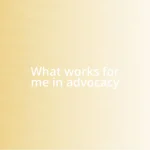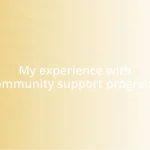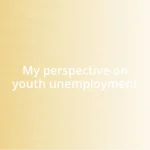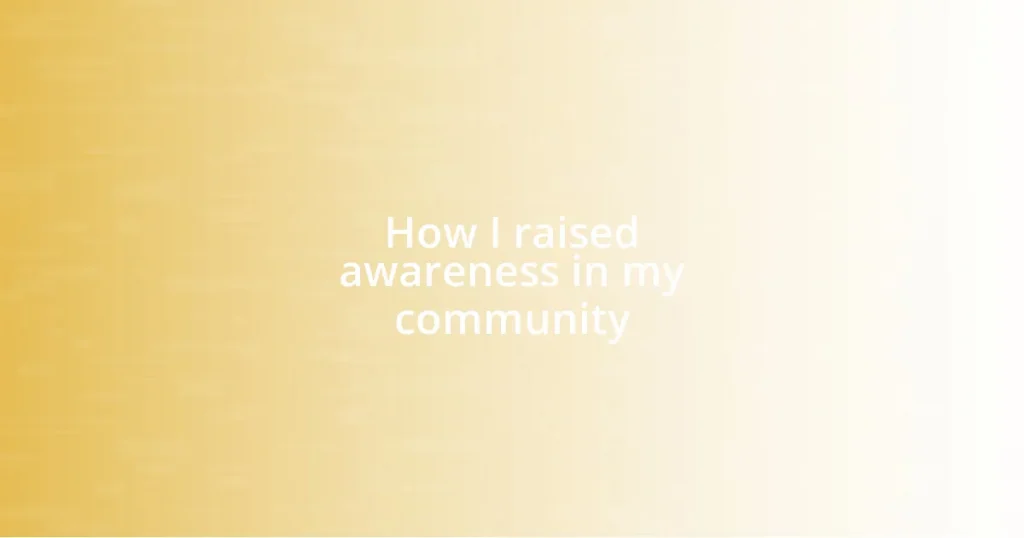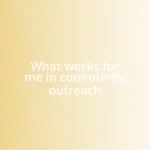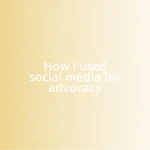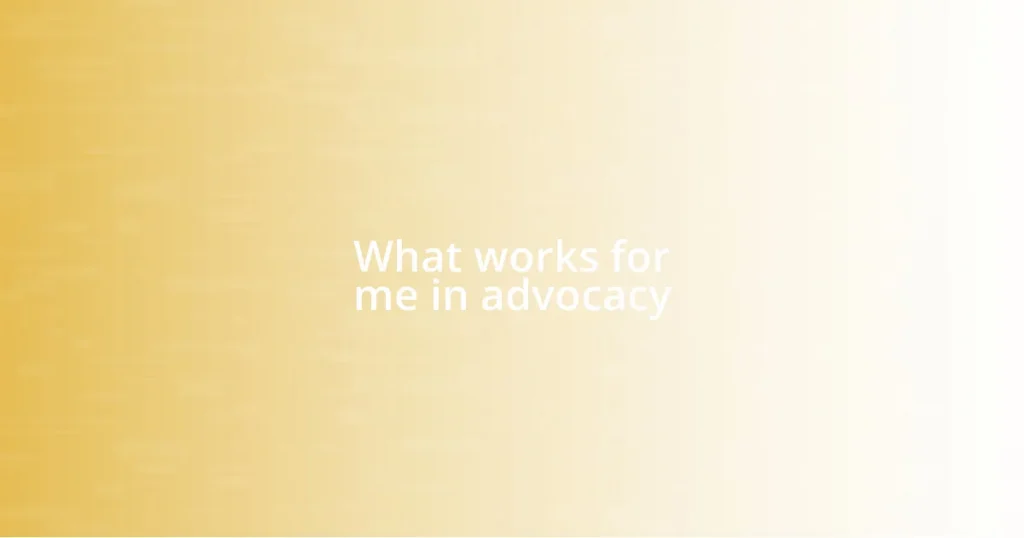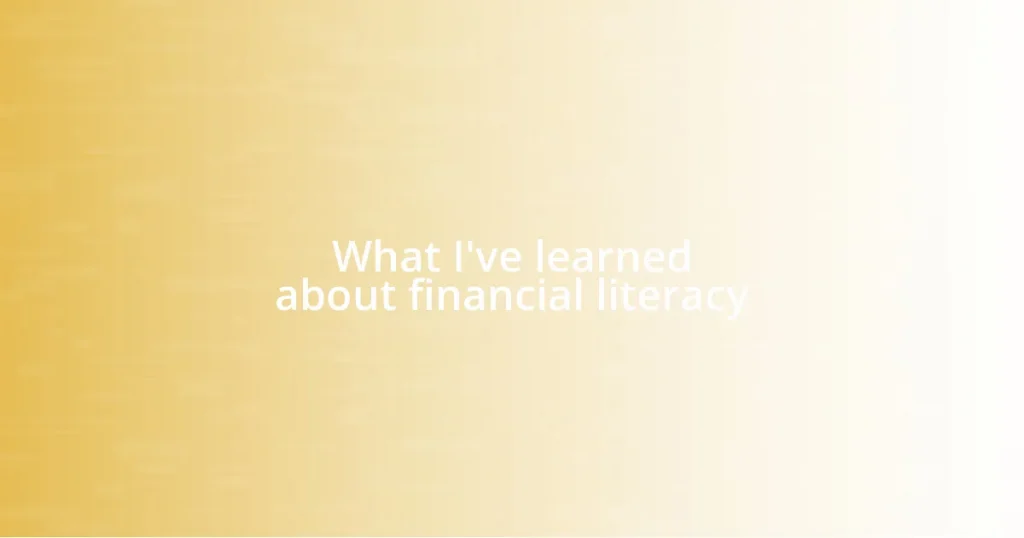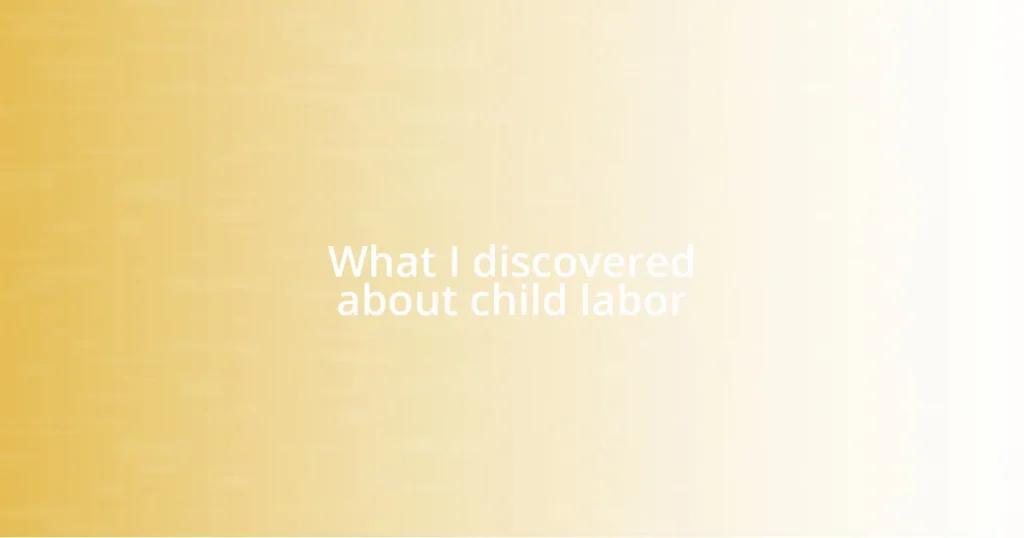Key takeaways:
- Understanding community needs involves active listening and empathy to bridge gaps in awareness and resources.
- Engaging with community leaders fosters collaboration and strengthens awareness initiatives through shared goals.
- Social media serves as a powerful tool for outreach, enabling conversations and community engagement around local issues.
- Organizing local events creates a sense of ownership and community involvement, enhancing long-term engagement through inclusive environments.

Understanding community awareness needs
Understanding community awareness needs involves diving deep into the heart of what resonates with the people around us. I remember attending a community meeting once, where residents expressed frustration over local health issues, yet there was a palpable lack of information about available resources. It made me wonder: how often do we truly listen to the voices around us?
Through my own experiences, I’ve learned that awareness needs can be as diverse as the individuals in a community. For instance, while some may crave information about environmental concerns, others might prioritize access to mental health services. Reflecting on that meeting, I found myself thinking—how can we bridge these gaps in understanding what different groups truly require?
One powerful insight is how emotions play a crucial role in awareness. I noticed that when we shared personal stories—like the impact of pollution on a child’s asthma—it sparked a deeper connection. Isn’t it interesting how personal experiences can lay the groundwork for collective understanding? Recognizing these needs takes more than observation; it requires empathy and a commitment to fostering genuine dialogue.

Identifying key issues to address
Identifying key issues starts with keen observation and meaningful conversations within the community. I recall sitting at a local café, chatting with neighbors over coffee. The discussion turned to local education, and I was struck by the number of parents who voiced concerns about inadequate school resources. It reaffirmed for me that sometimes, simply being present and engaging in casual dialogue can unearth significant issues that need addressing.
Another valuable approach is conducting surveys to gather feedback directly from community members. I organized a small survey after witnessing recurring discussions about transportation challenges. The results were eye-opening; various demographic groups had unique barriers, from lengthy commutes to inaccessible public transport. This demonstrated that understanding key issues often requires us to step aside and let our community’s voice guide the conversation.
Lastly, analyzing community events can provide insight into collective interests and struggles. During a recent local fair, I observed the booths that garnered the most attention—health screenings and job opportunities. It struck me how a simple gathering could reflect broader priorities. Recognizing these nuances in community dynamics is essential for targeting awareness efforts effectively.
| Method | Description |
|---|---|
| Conversations | Engaging informally to identify immediate concerns |
| Surveys | Collecting direct feedback from community members |
| Event Analysis | Observing community participation to understand priorities |

Engaging with community leaders
Engaging with community leaders has been a transformative aspect of my journey in raising awareness. I distinctly remember the first time I reached out to a local leader; it was a chilly afternoon, and I was nervous. I casually introduced myself at a town hall meeting and shared my thoughts about community health initiatives. To my surprise, the leader not only listened but also expressed enthusiasm about partnering on awareness campaigns. That moment reinforced my belief in the power of dialogue—it’s amazing what can unfold when we take that first step.
To foster meaningful collaborations with community leaders, it helps to approach conversations with openness and respect. Here are a few approaches that have worked for me:
- Listen Actively: Engage in genuine conversations and truly hear their perspectives.
- Share Personal Stories: Narrating relatable experiences can bridge gaps and create a shared vision.
- Identify Common Goals: Align your awareness initiatives with the priorities they champion in the community.
- Follow Up Regularly: Building relationships requires ongoing dialogue rather than a one-time interaction.
- Celebrate Small Wins: Recognizing achievements encourages continued partnership and fosters a sense of unity.
By weaving together insights and experiences, I found that collaborating with community leaders not only amplifies awareness efforts but also strengthens the community itself.

Utilizing social media for outreach
Utilizing social media for outreach proved to be a game-changer in my efforts to raise awareness. I vividly remember the first time I turned to platforms like Facebook and Instagram. I crafted a simple post about local education funding, sharing a heartfelt story about a child in my neighborhood who faced challenges due to outdated resources. The response was overwhelming. Within hours, parents began sharing their own experiences, and what started as a small conversation blossomed into a community-wide dialogue. Isn’t it fascinating how digital connections can bring people together in ways we never imagined?
As I explored various social media tools, I discovered the power of visuals. I began creating infographics highlighting critical issues, like the statistics around transportation access in our area. One particular graphic I shared about the lack of bus services led to an online discussion that drew attention from local officials. Watching neighbors passionately engage in the comments section reminded me that social media isn’t just a broadcast channel; it’s a vibrant space for conversation and collaboration.
I also found that hosting live Q&A sessions on platforms like Instagram helped deepen our outreach efforts. The first time I went live to discuss health issues within our community, I was nervous. But soon, people started tuning in, sharing their questions and stories. It felt like a genuine gathering, bringing together diverse voices. This experience confirmed what I believed: social media is more than just a tool; it’s a lifeline that connects us, promotes understanding, and ignites action. How have you experienced the power of social media in your community?

Organizing local events for involvement
Organizing local events has been crucial in igniting community involvement. I recall the first neighborhood cleanup I organized; it started as a small idea in my head, but once I secured a date and enlisted a few friends, magic happened. Word spread quickly, and on a sunny Saturday morning, I was amazed to see more than twenty faces ready to roll up their sleeves. The energy was electric, and it felt like everyone had a stake in creating a cleaner environment together.
To make these events successful, I learned to tap into local resources. Partnering with schools and community centers allowed us to access spaces and promote events effectively. For instance, when we hosted a health fair, using the local school gym not only provided a venue but also attracted families who were already engaged with the institution. Plus, I encouraged local businesses to sponsor or provide refreshments, which resulted in a delightful sense of camaraderie and support. It’s incredible how collaboration enhances participation, isn’t it?
Reflecting on these experiences, I recognize that the heart of organizing events lies in creating an inviting atmosphere. At one gathering, a shy neighbor approached me, expressing how she had always wanted to get involved but didn’t know where to start. By fostering an environment that embraced newcomers, I saw not just an increase in attendance but a flourishing of voices that enriched our community dialogue. Isn’t it rewarding to see how little efforts can bring people together and inspire lasting involvement?

Sustaining long-term community engagement
Sustaining long-term engagement in the community requires consistent effort and genuine connection. I remember a community forum we held six months after our initial clean-up event. We invited everyone back, not just to revisit past achievements but to discuss future goals. I was pleasantly surprised when locals, who hadn’t participated earlier, showed up, fueled by that initial spark of community spirit. It reminded me that when people feel their voices are valued, they’re more likely to contribute over the long haul.
Another key aspect is the power of follow-up. After hosting our health fair, I decided to send a heartfelt thank-you note to every participant and volunteer. I shared how their involvement had made a difference in our collective health awareness. The feedback was inspiring; many felt appreciated and expressed interest in future initiatives. It reinforced my belief that acknowledging contributions can cultivate a sense of ownership and inspire ongoing participation. Have you ever noticed how a simple thank-you can motivate people to stay involved?
I’ve come to realize that storytelling plays a vital role in maintaining engagement. For instance, during our meetings, I often share personal stories of people positively impacted by our initiatives. Last month, I shared a touching account of a young mother who accessed vital health resources thanks to our efforts. The room was silent, absorbed in the narrative. This emotional connection cultivated a shared commitment, transforming our gatherings from mere events into a connected community. How has storytelling worked in your own experiences to build lasting ties?
